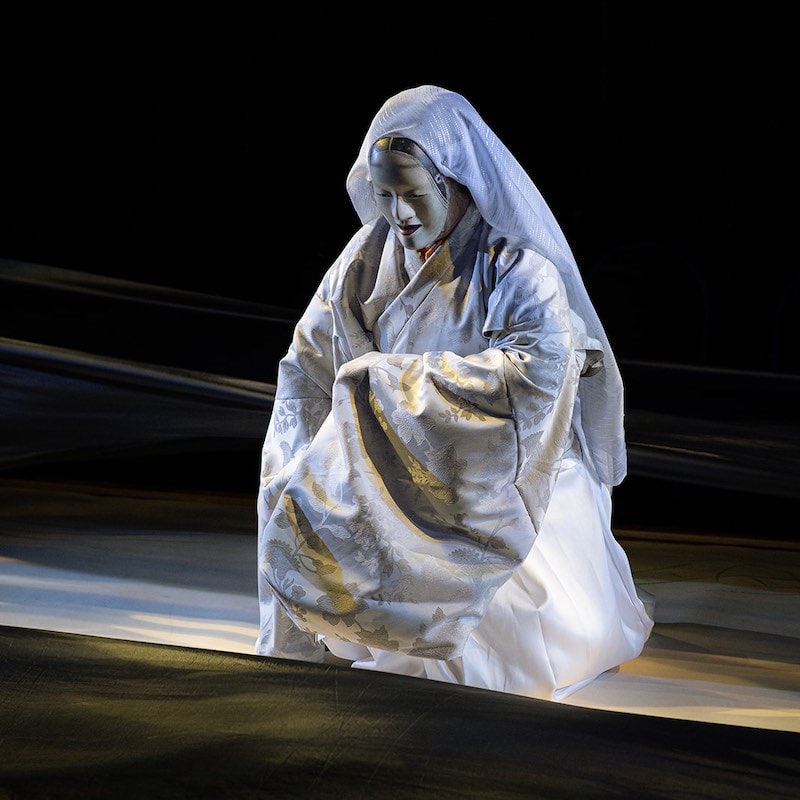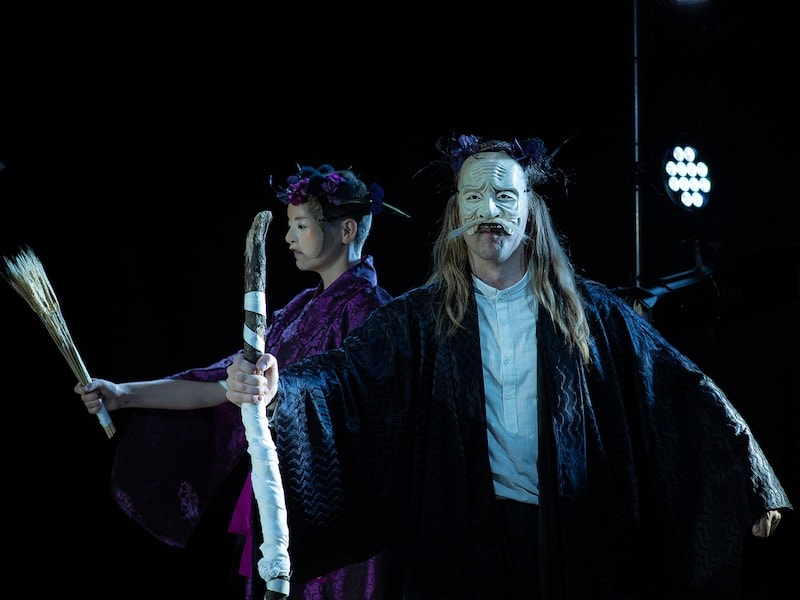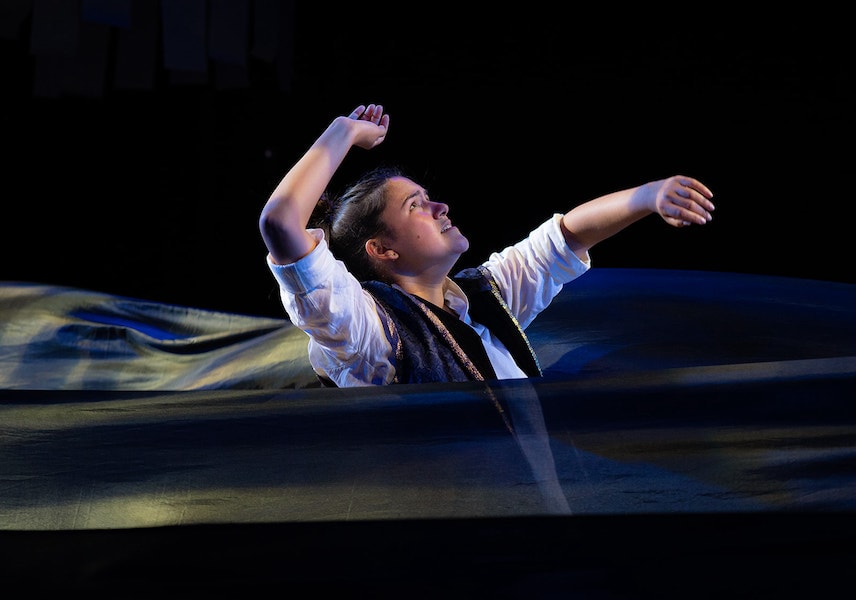IN Series’ The Nightsong of Orpheus is a magnificent spectacle that is not to be missed. It is magical, delightful, devotional, and — in line with IN Series’ mission — eminently hopeful.
Part of what The Nightsong of Orpheus is specifically about is grief — the loss of something or someone, and what that something or someone meant in our lives. It is also about establishing spaces in which that grief can be held and the lost person or thing can be remembered and honored.
Nightsong intertwines text from the highly sensual Song of Solomon with the devout ritual of the vespers and the pagan myth of Orpheus — a confluence of the sacred and the profane that is at the heart of this production of the story of Orpheus’s love and loss.

Orpheus, the son of the god Apollo, was a magnificent musician. He fell in love with Eurydice. It is predicted that their perfection will not last. While in the forest cavorting with nymphs, Eurydice is bitten by a snake and dies instantly. Orpheus descends to the underworld and sings of his grief. The god of the underworld allows Orpheus to take Eurydice back with him under one condition: she would have to walk behind him as they progressed out of the caves of the underworld, and Orpheus could not turn to look at her as they walked. Orpheus, at the last moment, glances back, and Eurydice is returned to the underworld forever.
Grief is the same across all cultures. It is transformative and usually unwelcome. But one must be willing and courageous enough to create, allow, and honor the space necessary for the distinct and differing languages of whatever the grief is that needs to be expressed. We live in a many-cultured city that has walls between the cultures inhabiting it. It is a welcome effort that this production is making — to be concerned with the testimony, confrontation, and affirmation of grief across and between different cultures and languages.
IN Series enlisted a juggernaut of a team to make that intercultural encounter truthful and engaging: Theatre Nohgaku, Akira Matsui, Kitazawa Hideta, and Deb Kim Sivigny, along with lighting designer Paul Callahan.
In 1998 actor and teacher Akira Matsui was designated an Important Intangible Cultural Property by the Japanese government. He literally embodies the Noh tradition for us on the IN Series stage.
Kitazawa Hideta’s masks help us engage with the liminal space between Western and Japanese cultural perceptions. Throughout the performance, various actors put on these masks and thereby move from being members of a chorus into the role of specific characters in the Orpheus story.
We are able to inhabit and follow this Nightsong of Orpheus largely because of the costume and scenic designs Deb Kim Sivigny has provided. They help focus our attention on the characters and the progression of the story. Her designs are evocative, useful, direct, simple, and practical. Maybe because they are severely focused on serving the constant cultural intermingling of text, music, and ritual, those designs end up also being surprising, spectacular, amazing, and — more often than one has a right to expect — breathtaking.
In Nightsong the traditions of Noh theater are called upon to tell a story that is written in a European tradition. The Noh tradition is suffused with music and movement in a way that differs from the European one. The challenge of having these different traditions share the stage simultaneously while allowing each to manifest their own integrity is confronted immediately.

The performance opens with the entrance of Akira Matsui — in Noh mask and costume — stepping onto the stage and giving us a searing announcement of the evening’s theme, as expressed in the Noh tradition. This is immediately responded to by a correspondingly searing reverberation of that theme in Monteverdi’s composition. For me, this confrontation and sharing of experience in which each cultural expression was fully present on its own terms was so successful that I could have gone home then. But there was much more to follow.
The audience is divided into two groups that face each other across a rectangular platform that runs the length of the space between the two groups. The action takes place on this platform. Instead of looking at the stage as a set for a performance, we are invited — you might say compelled — to regard the space as holy ground.
Images that were highlights for me:
The blocking of specific dances as well as the marshaling of cast members with multiple activities happening at different ends of the platform effectively enabled us to experience a panoramic view of the world the characters inhabit. There are times when your responsibility as an audience member is to sit still and observe. The work of Theatre Nohgaku’s Jubilith Moore on this production brought about that feeling for me.

The work builds to the second act, in which Orpheus undertakes crossing the river into the underworld. That river takes up the entirety of the stage and the audience’s view, with wind from the waves blowing the audience as well, helping strengthen the feeling of immersion in the experience.
There was a moment when Orpheus accepts the truth of Eurydice’s being a part of the underworld by seeing her draped in a transparent black material, which, when he tries to remove it, seems to yield but instead returns to its shape encasing her.
The path leading out of the underworld is staged as a curving one, with suspense-filled opportunities for Orpheus to accidentally see Eurydice as they walk away from the underworld. I am sure I am not the only one who held my breath, waiting to see whether this was the moment when Orpheus would mess up.

Three-quarters of the way through the second act a figure looking like a golden Buddha arrives. I think it was a representation of Apollo leading Orpheus to his final ascension as a constellation in the skies. I kept watching for the golden figure’s eyes to move until I accepted the fact that this was a mask, too.
The realization of the musical aspects of the production was a discovery. Richard Emmert brought another essential authentic Noh aspect through his playing of the fue (bamboo flute) and the taiko (drum). The early European instruments were masterfully handled by the INnovātiō Baroque Orchestra.
The singer/actors were all wonderful with strong but balanced harmonies. But I was especially impressed with the work of countertenor Hunter Shaner.
The Nightsong of Orpheus is a unique experience that you are not likely to see done as provocatively anywhere else — except maybe outside the U.S. It is a stimulating, rigorous, and hopeful evening of storytelling, shared with a high level of craft and skill.
Running Time: Approximately two hours 15 minutes with a 25-minute intermission.
Performed in English and Japanese.
The Night Song of Orpheus played on September 9, 10, and 11, 2022, presented by IN Series in partnership with Theatre Nohgaku performing at Source Theater, 1835 14th Street NW, Washington, DC.
There will be four more performances in DC:
September 16 at 7:30 pm
September 17 at 2:30 and 7:30 pm
September
18 at 2:30 pm
in Dupont Underground, 19 Dupont Circle NW, Washington, DC (a non-ADA-accessible venue). Purchase tickets (from $35 plus a $3 fee) online.
And there will be three performances in Baltimore:
September 23 at 7:30 pm
September 24 at 7:30 pm
September 25 at 2:30 pm
at Baltimore Theatre Project, 45 W Preston St, Baltimore, MD. Purchase tickets (from $35 plus a $3 fee) online.
COVID Safety: Everyone must wear a mask at all times when inside. IN Series’ full COVID policy and procedures can be read here.
The Nightsong of Orpheus
Music by Claudio Monteverdi from his Vespers and L’Orfeo
Directed and Conducted by Timothy Nelson
Design by Paul Callahan and Deb Sivigny
Presented by IN Series in partnership with Theatre Nohgaku
Actor Singers: Tony Boutté (Orpheus), Aryssa Leigh Burrs (Speranza, Orpheus), Hunter Shaner (Messaggiera), Oliver Mercer (Apollo), Janna Critz (Prospernia), Mara Yaffee (Eurydice), Robin McGinness (Pluto), Cara Schaefer (Speranza), Akira Matsui The Godhead (Music, Hope, Apollo)
Musicians: Timothy Nelson (Music Director, Harpsichord, Organ), Emily Baltzer (Harpsichord), Daniel Boothe (Violin), Claudia Combs (Violin), Richard Emmert (Fue, Taiko), Joshua Keller (Lirone, Treble Viola da Gamba), Niccolo Seligmann (Bass Gamba), Cameron Welke (Theorbo)




